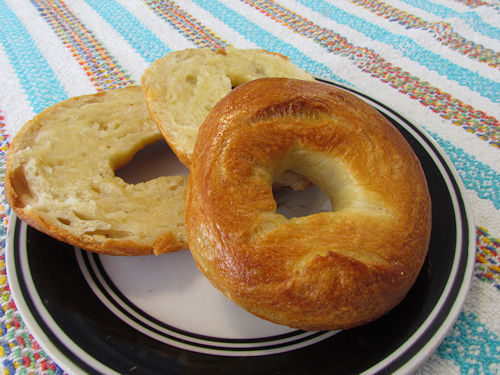365Caws is now in its 16th year of publication. If I am unable to post daily, I hope readers who love the natural world and fiberarts will seize those days to read the older material. Remember that this has been my journey as well, so you may find errors in my identifications of plants. I have tried to correct them as I discover them. Likewise, I have refined fiberarts techniques and have adjusted recipes, so search by tags to find the most current information. And thank you for following me!
Friday, May 8, 2020
The Better Bagel
Day 208: Without question, a bagel should have character. Whether you spread it with cream cheese or butter, the unique taste of the bread should carry through to your palate. Even with lox (a potent flavour indeed!), the bagel should provide a strong base to support its accompaniment. Having not made bagels in probably 30 years, it shouldn't have surprised me that I couldn't find my recipe. I searched all my cookbooks, leafed through all the cards in my file box to be sure I hadn't misplaced it, but I could not find the recipe I knew I'd used. I recalled that it used potato water. That was always a sticking point when I wanted to bake bagels: whether or not I had a spud on hand. The recipes in my assorted books were all milk-based. Milk? In a bagel? Unthinkable! Still, desperate times call for desperate measures, so I used the recipe in the Jones' "Book of Bread" which was almost identical to the one in "Joy of Cooking." That was Wednesday. The result was insipid, bland, flavourless, flat and hardly worthy of the butter I spread on them when I sampled them. I sent out an all-points bulletin to friends, and two responded with a recipe I had also seen on Kosher.com. Halved, it appeared to be close to my tried-and-true (and mislaid) version. I made bagels again on Thursday, real bagels, good bagels, bagels with crunchy crusts and tender, light middles. Alas for having no cream cheese, butter sufficed quite nicely, thank you, and I reproduce the Crow-adapted recipe here as a public service.
Bagels - Makes 12 - Oven temp 425 degrees - Cooking time 23-25 minutes
First, boil a large potato in enough water to yield 1 1/4 cups when drained. Do something else with the potato. It's the water you want. Cool it to lukewarm, or if you're reheating it, reheat it to lukewarm.
Dissolve a scant Tbsp. of dry yeast in 1/4 cup of the potato water. While it's softening, sift 3 1/4 to 3 1/2 cups of flour. In another bowl, thoroughly combine 1/8 cup vegetable oil, 2 tsps. salt, 2 eggs and the remaining potato water. Add 1/2 cup of flour, then add the dissolved yeast. Now stir in enough additional flour to make a soft dough. Turn the dough out onto a floured board and knead for 10 minutes, adding more flour as required (repeat caution here: NEVER force dough to take more flour than it wants!). Place the dough ball in a greased bowl and turn it once to grease both sides. Let raise in a warm place for 1 to 1 1/2 hours (until doubled). Divide the dough into 12 pieces. Form each one into a rope about 6" long and join the ends by dampening them with water and pinching or rolling them together to form circles. Place each shaped bagel on a lightly floured board to prevent sticking. If the holes want to swell shut, stretch them gently apart with floured fingers. Let the shaped bagels rest for 15 minutes while you bring 3 quarts of water plus 2 Tbsp. sugar to a boil. Now comes the fun part! Drop each bagel into the boiling water, no more than three to a pan. They will sink to the bottom. When they float free and the water begins boiling again, time them to boil 1 minute, then flip them over and boil for another minute. Lift them out with a slotted spoon and place on a parchment-lined baking sheet, leaving plenty of space between them. Whip a whole egg and brush on the tops to make a nice glaze. If you're of a mind to do so, you can press poppy/sesame seeds or onion bits onto the glaze. I prefer mine plain. Bake at 425 degrees for 23-25 minutes, depending on how crisp you like the crusts. Enjoy your bagels hot or cooled!
Subscribe to:
Post Comments (Atom)

No comments:
Post a Comment